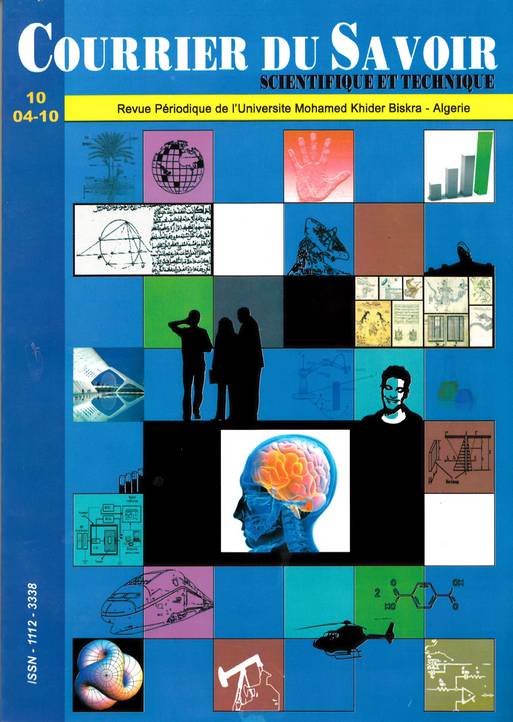AJUSTEMENT LINEAIRE DE LA TECHNIQUE BOLD DE L'IRMF
Résumé
L'objectif principal de notre travail est de faire un ajustement linéaire de la technique BOLD (Blood Oxygenation Level
Dependent) de l'IRMf. Ce qui permet de mieux étudier et explorer cette technique. Celle ci comporte une réponse
hémodynamique (hrf) dont la forme a été choisie par Friston & Al en 1994[1] et qui dépend du taux d'oxygène dans le sang, du
débit et du volume sanguin .Pour cette raison on a appliqué une technique mathématique d'ajustement sur la base du modèle
linéaire;qui contient le bus de données des trames d'image (la série temporelle) , la matrice expérimentale , la régression ou
bien les paramètres voulus de l'estimation et Finalement l'erreur du calcul qui doit être minimale.
D'après le modèle linéaire et l'application de t-test Student on trouve une activité inférieure a 0.05. Ceci est visualisé sur une
glass de Talairach.
Références
functional Images of the Brain' , These N 2671.2002
[2] Vincent DENOLIN, Thierry METENS et Philippe
VAN HAM. « Imagerie Fonctionnelle par RMN -
Systèmes logiques et Numériques- », 1999
[3] Sophie Schwartz, "Informations sur l'IRM" - download
une version pdf de ces information, 12 sep 2003.
[4] BOTTOMLEY PA., HART HR., EDELSTEIM WA.,
ET AL., Anatomy and metabolism of the normal
human brain studied by magnétic resonance at 1.5
Tesla Radiology 1984; 150 : 441-446.
[5] Traitement des images IRMf avec SPM’, Journées de
formation en IRMf: introduction, 26-30 septembre
2005,
[6] [6] Rik HENSON, “Analysis of fMRI Time series:
Linear Time-Invariant Models, Event-related fMRI and
Optimal Experimental Design”, chapitre10,The
Wellcome Dept. of Imaging Neuroscience & Institute
of Cognitive Neuroscience, University College
London, Queen Square, London, UK WC1N 3BG.
[7] [7] Michel DOJAT. I : « L’Imagerie par Résonance
Magnétique Anatomique et Fonctionnelle-Rappel des
Principes de base et Artéfacts » U594.Université
Joseph Fourier. Grenoble I.
[8] [8] BRADLEY WG., Fundamentals of NMR image
interpretation. In : Bradley WG, Adey WR, Hasso,
head and neck :a text atlas . Rockville, Md. :Apsen,
1985.
[9] Line GARNERO. « Imagerie cérébrale fonctionnelle:
Techniques et applications » Laboratoire de
Neurosciences Cognitives& Imagerie Cérébrale, CNRS
UPR640 .Centre de Magnétoencéphalographie
[10] « Voir dans le cerveau », La recherche, N0 289 de
Juillet-Août 1996.
[11] Jeffery .J.Orchard, B.Math, "Simulatanious
Registrationand Activation Detection Overcoming
Activation-Induced Registration Functional MRI",
University of Waterloo,1994, M.Sc., University of
British Columbia ,1996,Simon Fraser University ,
April 2003.
[12] Charles BOUVEYRON, " ANALYSE DES IMAGES
D’IRMF", 16 décembre 2002.
[13] S.J.Kiebel & A.P.Holmes, "The general linear model".
[14] Christensen R.1996, Plane Answers to Complex
questions: The theory of linear models Springer Verlag
Berlin.
[15] Friston K., Holmes,A , Worsley, K.Poline, J.Frith, C ,
and Frackowiak , R1995. Statistical parametrise maps
in functional imaging .Ageneral linear approach,
Humman Brain mapping, 2189-210.
[16] Traitement des données KH sous spm, coriandre vilain,
6 juillet 2004.
[17] Siugna Horizon LX, « Ecran Scan Timing (Temps de
répétition(TR)) :Chapitre12– Acquisition temps
d’acquisition), Manuel de référence 2148088-101, Rev
1,(6/97)
[18] CALLEN H.B AND WELTON T.A., Irreversibility
and generalized noise. Phy.Rev., 83 : 34-40. 1951.
[19] KAUFMAN L., SHOSA D., Quantitative
characterization of signal to noise ratio in diagnostic
imaging instrumentation. In : Progress in Nuclear
Medicine, Neuro-Nuclear, Juge O, Donath A,editors.
Basel. Switzerland : S.Karger AG, 1981.


